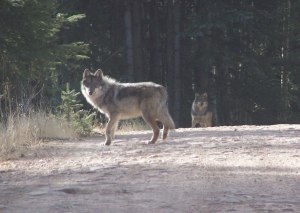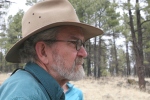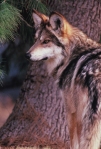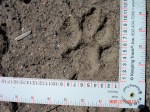The first evening I woke up to the sounds of wolves. The howls were spare and singular, two voices calling to each other and to the night.
Crawling out of the tent to hear more clearly, I felt the lonely cusp of mountains around me. I had the campground at Luna Lake near Alpine, Arizona all to myself, though I could picture it in the summer splashed with families and loud music, children running by the water and fishermen casting lines. Now it was empty, on a cold Spring night under the fused brightness of moon and stars.The wolves weren’t close, their throaty howls magnified across the water.
I listened, shivering, until the forlorn barking of dogs in a primal chorus drowned out the wild sounds, and soon it was quiet again. A deep, feral part of me longed to be one with the darkness, pulled towards its mysteries. Yet I felt so acutely my separation from the forest and the moon polished mountains rising beyond the pale beam of my flashlight. Somewhere the silent drop of footpads pressed against the earth, wolves nosing the air for the messages of the night, shadows brushing shadows before they vanished in its dark embrace.
The next morning I woke at dawn and drove into Alpine. My cellphone wasn’t working so I knocked on the window of a steamy truck idling before the town’s only cafe opened, startling the sleepy men inside. Twenty minutes later I was sitting at a table in the half-finished home of Billie Hughes and Russ Winn, the local couple who were lodging two legendary conservationists for the weekend.
Dave Parsons came in first, heading straight for the cold-pressed coffee. He was a grey wolf himself: slight of stature, grizzled and wary. Now retired, Dave was the biologist who led the U.S. Fish and Wildlife Service’s wolf release program in the Southwest for many years. His words were spare, knotted with encyclopedic knowledge and dry humor.
When John Davis entered the house he immediately introduced himself to me, warmly offering his hand.
Davis, every inch of him muscle thickened over bone, was a few hundred miles into his TrekWest journey: he would travel 5,500 human-powered miles from Mexico to British Columbia in the next few months, backpacking, biking and paddling. His blue eyes flickered over the room, restless above a scruff of beard on clapboard cheeks, keen as an animal unleashed in new territory.
The tangible purpose of TrekWest was to see if Davis could map a wildlife migration corridor along the spine of the continent, despite habitats fragmented by highways, extractive industries and residential developments. Along the way he would be supported by local organizations and, he hoped, bring a unifying thread to state-based conservation campaigns. The more personal reasons, he shared with me, were to pay homage to his mentors in the environmental movement, and to his parents. John’s mother, a huge influence in his life, had passed away from cancer while he was doing the eastern portion of his epic journey, 7,200 miles on TrekEast in 2011.
John and Dave had just finished a week-long backpack trip through the Gila Wilderness together, where they traced the spoor of wolves. Now I joined them in Alpine for a quiet celebration of the 15th anniversary of the first release of the Mexican Gray Wolf into a landscape where the last one had been sighted, and slaughtered in 1970.
As Russ made a breakfast of great slabs of pancakes topped with fresh peach jam, he filled in the story behind the “Green Fire” site we would visit.
There Aldo Leopold, looking into the eyes of a wolf he had just shot, finally understood that these maligned predators were essential to the cycle of life in the mountains he loved.
The big man’s voice boomed along the open rafters: earlier researchers had gotten it wrong, he told us. They made false assumptions when they tried to pin down the location where Leopold had this epiphany, deciding it happened on the banks of the Blue River. Studying maps and writings and letters, Russ and others concluded that the actual spot was on a cliff above the more remote Black River. He and Billie would take us there.
We drove as far as we could on the dirt roads of the Apache-Sitgreaves Forest. All around us were the ruins of the Wallow Fire, a tsunami of flames that consumed over half a million acres two years previously. Here I saw the changing face of fire. In places where the forest was healthy, it burned understory and singed the trunks of tall yellowbelly Ponderosas but left their canopies intact. Elsewhere, in the thick, tinder-dry mixed conifer areas, the Wallow blaze incinerated every living thing.
It was late morning as we hiked into the Green Fire site, and sunlight rippled sparks over the churning river. Russ and Billie led us to the rim of a bluff, the slope below littered with the riprap of fallen debris. There a wounded half-grown wolf had tried to hide himself after young Leopold and his friends carelessly pumped a hail of gunfire at a mother wolf greeting her playful pups. We shared a quiet few minutes as Billie set up her camcorder, balancing the light and securing the tripod, impatiently pushing back the white hair flicking into her youthful face. We heard only the sounds of the wind in the canyon and the thrum of white water until Dave started to read.
Dave read from Leopold’s essay, “Thinking Like a Mountain” while Billie filmed.
“We reached the old wolf in time to watch a fierce green fire dying in her eyes, I realized then, and have known ever since, that there was something new to me in those eyes–something known only to her and to the mountain. I was young then, and full of trigger-itch; I thought that because fewer wolves meant more deer, that no wolves would mean hunter’s paradise. But after seeing the green fire die, I sensed that neither the wolf nor the mountain agreed with such a view.”
Our quiet celebration held reverence, for Leopold, and for the ebbing pulse of a dying wolf. For a moment, not understood by Leopold until years later, when he knew man must live in balance with nature, not dominance of it.
I had spent time with the wolves. Seven years ago I was invited to the Sevilleta Wildlife Refuge in New Mexico, where wolves were kept before they were released. Along with a few other people, our job was to help herd the wolves into small cages for transport. We entered the fenced holding pen, guided by the USFWS biologist team. The two wolves were terrified.
Slightly smaller than my 65-pound dog, their tricolor coats of silver, black and brown easily blended into the shade-dappled landscape. They had long legs and a thick ruff, at least from the glance I caught as they ran from us.
Finally the male was cornered and forced into a cage by a swarm of shouting and clapping humans. He was tranquilized for a final health check, and one of the biologists explained to me that they wanted the animals so afraid of people that when released, they would stay as far away as possible from any human interaction. The veterinarian looked over the male, then clasped a four-pound radio telemetry collar around his neck. She told us that about half the wolves wore these heavy collars, so wildlife management field officers could track their whereabouts. I turned away. The magnificent animal lying under her hands had feces matting the fur on his belly and haunches, where he had defecated on himself from fear as he cowered in his cage.
The Mexican Wolf Recovery Plan was adopted in 1982 under the authority of the Endangered Species Act, though the first wolves were not released until 1998, in a designated area spanning part of the Apache-Sitgreaves Forest in Arizona into the Gila Wilderness of New Mexico. Success of the Plan would be measured when there were 100 wolves inhabiting the Blue Range Wilderness Recovery Area (BRWRA), with many breeding pairs.
Fifteen years later, the BRWRA is still a war zone. Of the 92 wolves released by the end of 2012, at least 42 of them have been shot. Fifty-six percent of all wolf mortality has been human-caused, either intentionally or by being hit by cars. Local ranchers blame every cow death on the wolves, and no shooting of a wolf has ever been prosecuted. Though the Defenders of Wildlife set up a fund to pay for lost cattle–which has been minimal–the ranchers still regard the wolf as an enemy to be exterminated.
The USFWS has removed 154 wolves from the wild due to nuisance complaints over the years. There were no new releases from 2007 to the end of 2012 as the wildlife agency succumbed to pressure from the local Cattle Growers Associations. New Mexico’s Game Commission voted in 2010 to rescind the state’s participation in the Recovery Program without any public discussion of their decision. However, the Federal program continues. In April 2013, four wolves were released, 2 in Arizona, and 2 in New Mexico, although one of them wandered out of the BRWRA and has already been recaptured. There are a recorded 75 wolves in the wild right now, but only two breeding pairs.
Is this really a return to the wild? The wolves are collared, tracked, trapped, shot, relocated, not free to define their own territories.
“Wildlife management is a crock,” Dave said, “Unfortunately, it is all we have.”
Late that afternoon Dave, John and I hiked up nearby Escudilla Mountain, the hump-shouldered giant I had seen driving to Alpine, covered with an icy glaze. It was cold and gray and started to snow as John and I raced towards the peak, Dave taking a more leisurely pace behind us. Leopold also wrote about this mountain. It was where the last grizzly bear ever seen in the Southwest was shot and killed by a trapper, his acid-cleaned skull sent to the Smithsonian Museum.
When we came down it was almost dark, the alpine meadow where we lingered collecting a rime of new snow, blue with twilight.
The next day Dave, John, Billie and I went to find the wolves. We hiked the lower hills backing up to Escudilla. I learned from Billie and Dave that I had in fact, heard wolves that night at Luna Lake. Two of them, forming a new pack had been sighted there, a collared female and a wild-born male.
Elk signs were everywhere. Trampled brush, black pegs of scat, hoof prints in the drying mud. Billie found the first faint wolf tracks, and Dave drew a folding angle ruler from his pocket to measure them.
The prints were large, about 4” by 2.5”, bigger than a dog’s or coyote’s prints. We followed a dirt road up to a fence line, then hiked the slope for a few hours, studying every lift of disturbed ground.
From an overlook we saw Escudilla in the distance, the black ambush of fiery devastation curling around the glittering peak. When we turned west to go back to the road we were surprised to see an empty Arizona Fish and Wildlife truck parked on Easter Sunday. Even though it was a holiday, the Ranger was most likely off on a wolf-related mission.
Alongside the road still wet from recent rain were more prints, pages of a story. Here a single wolf walked cautiously, his feet suckering in the mud. Was he tracking the elk, nosing the fresh scat and listening, attentive, to the sounds of the mountain?
We found another set of tracks not far from the first, evidence of the two roaming together, one large wolf, one smaller. Walking with Dave as he studied the terrain, I felt I was seeing an echo of time written on the land.
There on open ground were a barrage of prints, circling, entwined, trampled and smudged. In my mind I saw the wolves. Here they had stopped, chased each other, one rolling on the ground and the other grabbing a mouthful of ruff as they played on an early Spring evening, the greening world around them smelling of damp earth and musky grasses. New to the mountain, new to each other, they played as the last rays of sunlight warmed them, before the darkness called them home.
A few days later I asked a young man I work with why he cared about the wolves, since he lives in the city, far from anything to do with predators, cattle and forests.
“We owe it to them, after all we’ve done to them,” he said. “Besides, I like knowing they are there.”
Preserving critically threatened biodiversity; the importance of top predators in wildlife management; the return of healthy watersheds damaged by too many elk, all the scientific reasons given for the Gray Wolf Recovery Program circle around this truth: We need to know that something assuredly wild and free roams in the outside of our imaginations, where wilderness borders the choke of urban life.
There is comfort in that, for the part of us that still loves this world with its scars and losses, where a sudden wolf howl breaks the night with the voice of our joy and keening.









Leave a comment